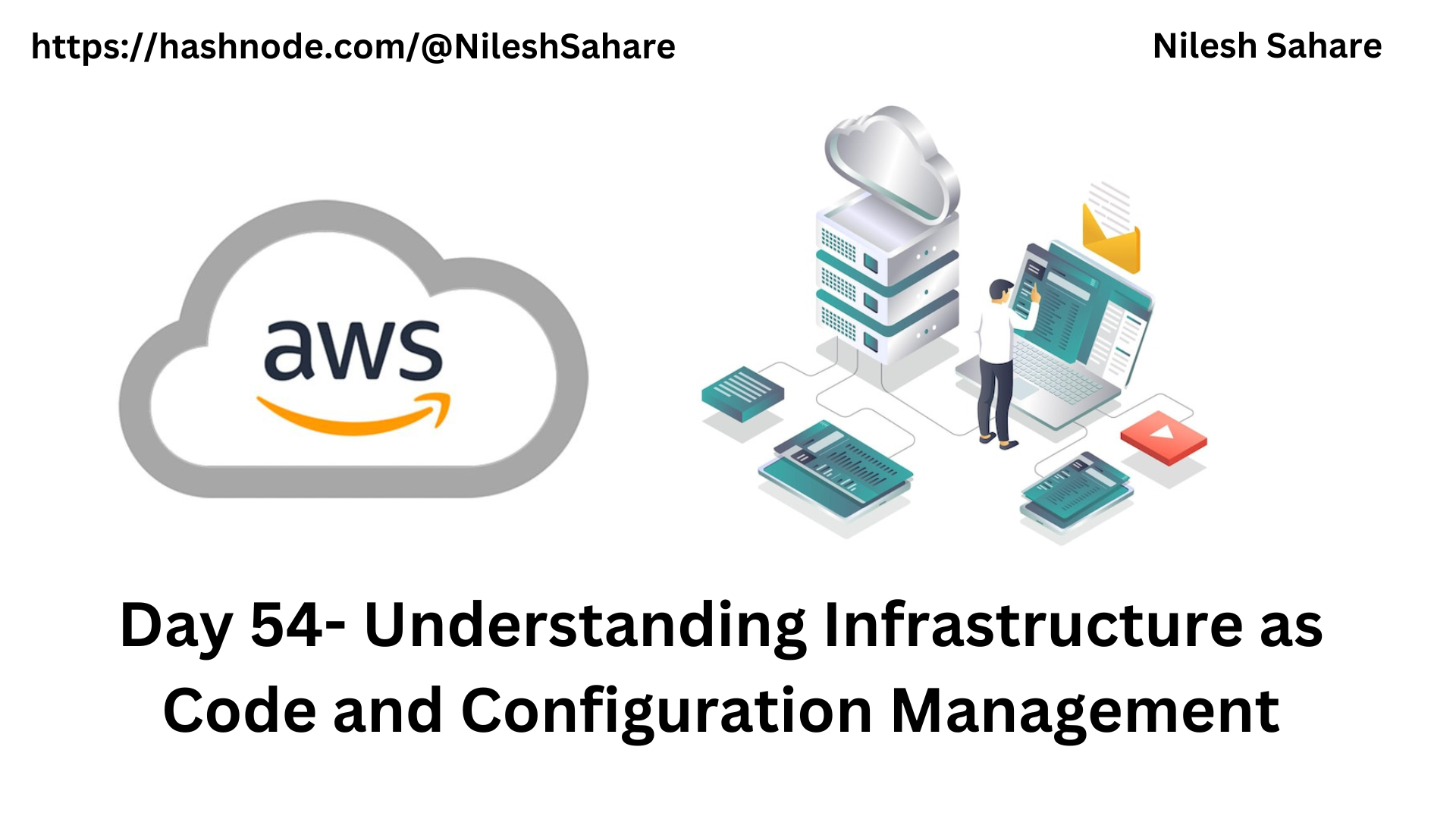Day 54 Task: Understanding Infrastructure as Code and Configuration Management
 Nilesh Sahare
Nilesh Sahare
🔶 What's the difference?
When it comes to the cloud, Infrastructure as Code (IaC) and Configuration Management (CM) are inseparable. With IaC, a descriptive model is used for infrastructure management. To name a few examples of infrastructure: networks, virtual computers, and load balancers. Using an IaC model always results in the same setting.
Throughout the lifecycle of a product, Configuration Management (CM) ensures that the performance, functional and physical inputs, requirements, design, and operations of that product remain consistent.
🔶 Task-01: Read more about IaC and Config. Management Tools.
Infrastructure as Code (IaC):
Infrastructure as Code (IaC) is a practice in which infrastructure environments are defined and managed using code and automation tools. It allows for the provisioning and configuration of infrastructure resources, such as virtual machines, networks, storage, and more, to be automated through code rather than manual processes. Here are some key points about IaC:
Automation: IaC automates the provisioning and management of infrastructure resources, reducing manual errors and ensuring consistency.
Code-Based: IaC uses code, often written in domain-specific languages (DSLs) like HashiCorp's HCL or YAML, to define infrastructure configurations.
Version Control: IaC code can be version-controlled using tools like Git, allowing for tracking changes and collaboration.
Scalability: IaC makes it easy to scale infrastructure resources up or down based on demand, reducing costs and optimizing resource usage.
Reproducibility: With IaC, you can recreate entire infrastructure environments quickly and consistently, making it ideal for disaster recovery and testing.
Cloud Agnostic: IaC tools can work with various cloud providers and on-premises infrastructure, promoting multi-cloud and hybrid cloud deployments.
Common IaC tools and frameworks include Terraform, AWS CloudFormation, Azure Resource Manager (ARM) templates, Google Cloud Deployment Manager, and Puppet, among others.
Configuration Management Tools:
Configuration management tools focus on ensuring that software applications and system configurations remain consistent and compliant over time. They are primarily used for managing the state of servers and applications within an infrastructure. Here are some key points about configuration management tools:
Configuration Drift: These tools prevent configuration drift by ensuring that servers and applications adhere to a desired state.
Idempotence: Configuration changes can be applied multiple times without causing issues, making them idempotent.
Declarative vs. Imperative: Configuration management tools can operate in a declarative or imperative mode. Declarative tools specify what the desired state should be, while imperative tools specify how to achieve that state.
Continuous Enforcement: They continuously enforce desired configurations, automatically correcting any deviations.
Agent-Based or Agentless: Some tools require agents to be installed on managed servers, while others are agentless.
Rollback: Configuration management tools often offer rollback capabilities to revert changes in case of issues.
Common configuration management tools include Ansible, Puppet, Chef, SaltStack, and Microsoft PowerShell DSC (Desired State Configuration).
IaC focuses on automating the provisioning of entire infrastructure environments using code, while configuration management tools ensure that servers and applications maintain a consistent and desired state throughout their lifecycle. These practices, when used together, help in achieving efficient and reliable infrastructure and application management.
🔶 Task-02: Give differences between both with suitable examples.
Infrastructure as Code (IaC) vs. Configuration Management Tools:
While Infrastructure as Code (IaC) and Configuration Management Tools share the goal of automating and managing IT infrastructure, they serve different purposes and have distinct characteristics. Here are the key differences between the two, along with suitable examples:
Purpose:
IaC: IaC focuses on defining and provisioning the infrastructure itself. It deals with creating and configuring servers, networks, and storage resources.
Configuration Management: Configuration management tools focus on managing the software configurations and ensuring that servers and applications are correctly configured.
Scope:
IaC: IaC manages the entire infrastructure environment, including servers, networks, databases, and cloud resources.
Configuration Management: Configuration management tools mainly deal with individual servers and their software configurations.
Level of Abstraction:
IaC: IaC operates at a higher level of abstraction, enabling the creation of entire environments using code. It's often used for provisioning cloud resources.
Configuration Management: Configuration management operates at a lower level, dealing with specific server configurations, packages, and services.
Declarative vs. Imperative:
IaC: IaC is typically declarative. It defines the desired end state of the infrastructure without specifying the steps to reach that state.
Configuration Management: Configuration management tools can be declarative or imperative. They often specify how to achieve a desired configuration state.
Example (IaC):
- Terraform: Terraform is a popular IaC tool. It allows you to define cloud infrastructure using code. For instance, you can use Terraform to provision AWS EC2 instances and configure VPCs.
Example (Configuration Management):
- Ansible: Ansible is a configuration management tool. It helps in managing server configurations and automating tasks like software installation and updates. For example, Ansible can ensure that Nginx is installed and configured correctly on a server.
Change Management:
IaC: IaC is well-suited for provisioning new infrastructure or making significant changes to existing environments.
Configuration Management: Configuration management tools excel at maintaining the consistency of existing configurations and managing ongoing changes.
Agent vs. Agentless:
IaC: IaC tools are often agentless and don't require agents to be installed on target systems.
Configuration Management: Configuration management tools may use agents (e.g., Puppet, Chef) or be agentless (e.g., Ansible).
State Management:
IaC: IaC tools maintain the state of infrastructure resources in state files to track the current state of the environment.
Configuration Management: Configuration management tools often apply configurations directly to servers, ensuring they match the desired state.
In summary, IaC is used to create and provision entire infrastructure environments using code, while configuration management tools are used to maintain and ensure the desired state of individual servers and their software configurations. These two practices can complement each other, providing comprehensive infrastructure automation and management solutions.
🔶 Task-03: What are the most common IaC and Config Management Tools?
The world of Infrastructure as Code (IaC) and Configuration Management offers a variety of tools to choose from. Here are some of the most common and widely used tools in each category:
Infrastructure as Code (IaC) Tools:
Terraform: Terraform is a popular IaC tool developed by HashiCorp. It is known for its multi-cloud support and infrastructure provisioning capabilities. Terraform uses a declarative configuration language called HashiCorp Configuration Language (HCL).
AWS CloudFormation: AWS CloudFormation is a native IaC service provided by Amazon Web Services (AWS). It allows you to define and provision AWS infrastructure using JSON or YAML templates.
Google Cloud Deployment Manager: Similar to AWS CloudFormation, Google Cloud Deployment Manager is a native IaC service for Google Cloud Platform (GCP). It uses YAML or Python templates to define and deploy GCP resources.
Azure Resource Manager (ARM) Templates: Microsoft's Azure Resource Manager provides ARM Templates for defining and deploying Azure infrastructure as code. These templates are JSON files.
Pulumi: Pulumi is an IaC tool that uses popular programming languages like Python, JavaScript, TypeScript, and Go to define infrastructure. It offers a programmatic approach to IaC.
IBM Cloud Schematics: IBM Cloud Schematics provides IaC capabilities for IBM Cloud resources. It uses Terraform under the hood but offers a simplified interface.
Configuration Management Tools:
Ansible: Ansible is an open-source configuration management tool that uses YAML-based playbooks to automate tasks, including software installation, configuration, and application deployment.
Puppet: Puppet is a well-established configuration management tool. It uses a declarative language to define system configurations and ensure systems adhere to those configurations.
Chef: Chef is another popular configuration management tool that uses Ruby-based recipes and cookbooks to automate system configuration and application deployment.
SaltStack: SaltStack, often referred to as Salt, is a configuration management and remote execution tool. It uses a Python-based language and is known for its speed and scalability.
Microsoft PowerShell DSC: Desired State Configuration (DSC) is a feature in PowerShell that allows you to define and enforce the desired state of Windows systems.
CFEngine: CFEngine is an open-source configuration management tool for both Linux and Windows. It uses its policy language to define configurations.
These tools serve different needs and have their strengths and weaknesses. The choice of tool depends on factors such as your specific infrastructure, your team's expertise, and your project requirements. Many organizations use a combination of both IaC and configuration management tools to fully automate and manage their infrastructure.
Happy Learning :)
If you find my blog valuable, I invite you to like, share, and join the discussion. Your feedback is immensely cherished as it fuels continuous improvement. Let's embark on this transformative DevOps adventure together! 🚀 #devops #90daysofdevop #AWS

Subscribe to my newsletter
Read articles from Nilesh Sahare directly inside your inbox. Subscribe to the newsletter, and don't miss out.
Written by

Nilesh Sahare
Nilesh Sahare
🎓 I hold a Post Graduate Diploma in Advanced Computing, which has equipped me with a strong foundation in cutting-edge computing technologies like MySQL Database (MySQL 8 on both Command Line client and Workbench), Data Structures and Algorithms using Java (Eclipse IDE), HTML 5, CSS 3, JavaScript, MERN, Software Development Methodologies (SDLC, STLC, JIRA, POSTMAN), JDBC , Servlet, Hibernate, Spring Boot, JSP (J2EE, STS IDE) LINUX Operating system and shell scripting. 📊 Current Role: Quality Assurance Engineer| 2 Year 3 Months and Counting 🧪 In my current role as a Quality Assurance Engineer, Automation and Manual Testing Tools: Selenium, Jira, TestRail, Postman, JUnit, . 🛠️ Learning the DevOps Way: Building Bridges 🌐 I'm on a continuous learning path, actively acquiring knowledge and hands-on experience with DevOps tools streamline collaboration between development and operations teams, encompassing popular solutions like Jenkins for continuous integration, Docker for containerization, Kubernetes for orchestration, Terraform for infrastructure as code, and Git for version control. 🤝 Let's Connect and Collaborate! 🌐